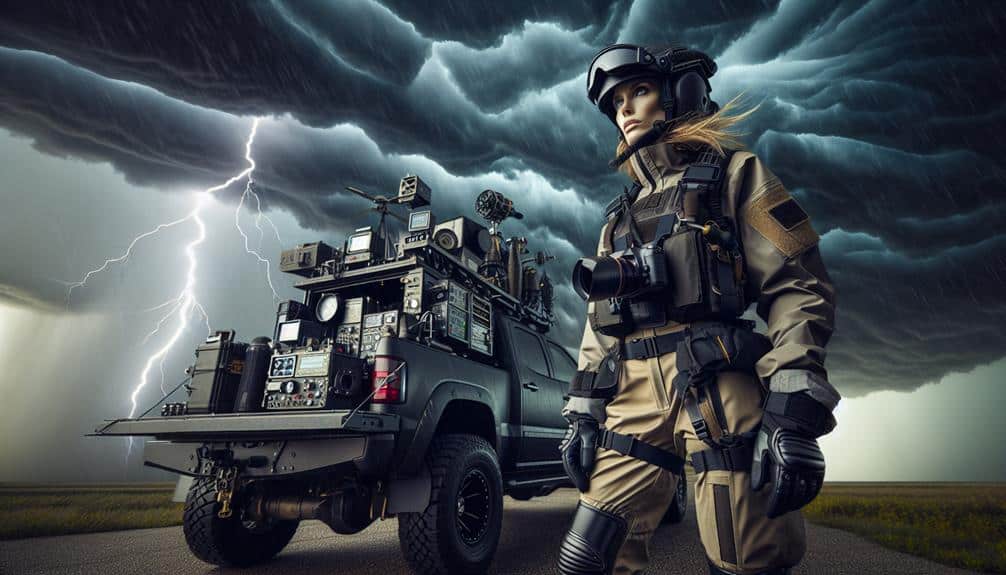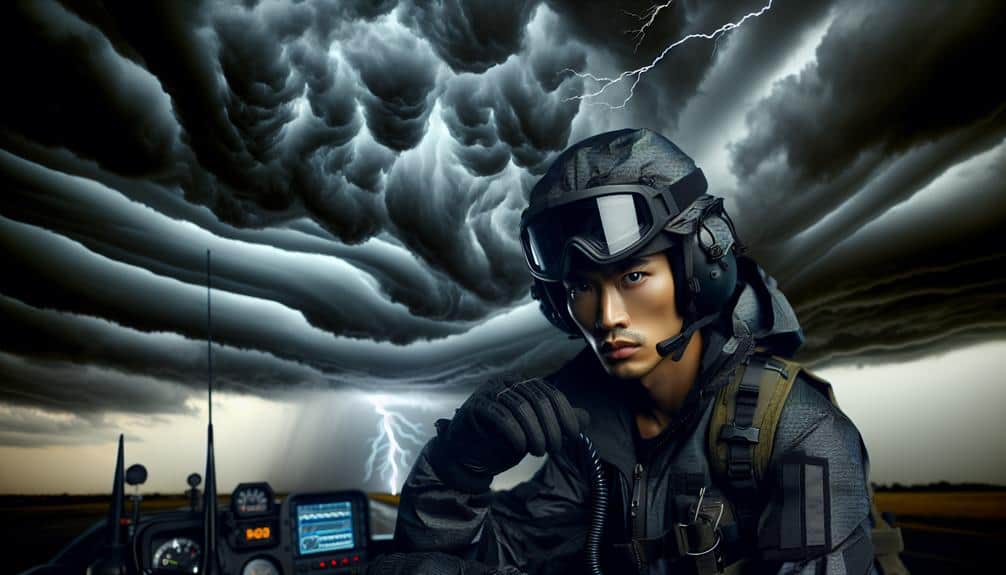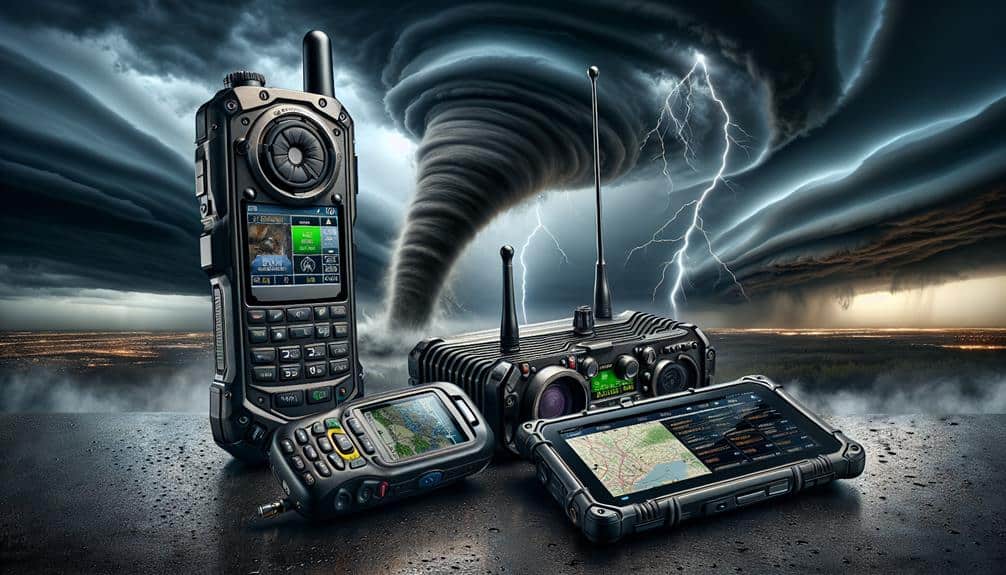When selecting the right high-visibility gear for storm chasing, we need to focus on several key aspects. First, verify all gear meets ANSI/ISEA 107-2020 standards for top-notch safety. Opt for bright colors like neon yellow and reflective materials to enhance visibility in low-light conditions. We should choose durable, waterproof fabrics like Gore-Tex or Cordura, which offer breathability and protection against harsh weather. Ergonomic design, breathable materials, and adjustable fits maintain comfort and functionality. Brands like 3M, Carhartt, and Helly Hansen provide industry-standard gear. To make informed decisions amidst severe weather, let's explore the detailed attributes that set the best gear apart.
Key Points
- Opt for high-contrast colors like neon yellow and reflective materials for maximum visibility.
- Choose durable, waterproof fabrics such as Gore-Tex or Polyurethane Coated Fabric for weather resistance.
- Ensure gear has ergonomic design and adjustable fit for flexibility and comfort during storms.
- Look for UV protection materials to maintain gear integrity in sunlight.
Importance of High-Visibility Gear
When we're out in the field, the importance of high-contrast gear can't be overstated, as it guarantees we remain easily recognizable and safe amidst the tumultuous conditions of a storm. Safety first, visibility second, is the mantra we must adhere to.
In the unpredictable environment of storm chasing, our gear ensures that we stand out against the backdrop of dark clouds, heavy rain, and debris.
High visibility essentials include bright colors—usually lime green, orange, or yellow—combined with reflective materials that catch and reflect light. These components are crucial because they enhance our visibility to both fellow storm chasers and emergency responders, reducing the risk of accidents or miscommunications.
The science behind these materials ensures that we can be seen from a distance and in low-light conditions, which is essential when we're moving through hazardous areas.
Moreover, industry standards dictate that high-contrast gear should comply with ANSI/ISEA 107-2020 specifications, ensuring that it meets rigorous criteria for visibility and durability. Adhering to these standards means we can have confidence in our gear's performance, even in the most extreme weather conditions.
Key Features to Consider
As we prioritize high-visibility gear for our safety, we must focus on key features such as material durability, reflective properties, and ergonomic design to guarantee peak performance in storm chasing scenarios.
First, let's talk about color options and reflective elements. Bright, contrasting shades like neon yellow, orange, or green enhance visibility even in low-light conditions. Reflective elements, strategically positioned on the gear, assure we're easily spotted by others, adding an extra layer of safety.
Next, a breathable design is essential. Our gear should allow for adequate air circulation to prevent overheating and maintain comfort during long chases. Advanced fabrics with moisture-wicking properties can help regulate our body temperature, keeping us dry and focused.
An adjustable fit also contributes significantly to our gear's effectiveness. Storm chasing demands flexibility and movement, so adjustable straps, cuffs, and waistbands are vital. These features allow us to customize the fit, making sure that our gear stays in place no matter how demanding the conditions.
Best Materials for Durability
When selecting high-visibility gear for storm chasing, we need to prioritize materials that guarantee durability under extreme conditions.
Waterproof fabric options are essential to keep us dry, while abrasion-resistant textiles protect against wear and tear.
Additionally, UV protection materials shield us from harmful sun exposure, preserving the longevity of our gear.
Waterproof Fabric Options
Selecting the right waterproof fabric is essential for high-visibility gear, as it must combine both durability and protection against harsh weather conditions. When we're out storm chasing, our gear needs to be reliable, comfortable, and functional. With that in mind, let's examine the top materials that meet these standards.
- Gore-Tex: This fabric is renowned for its breathable coatings, making it ideal for extended hours in the field. It provides superior water resistance while allowing moisture to escape, keeping us dry and comfortable.
- eVent: Another excellent choice, eVent features advanced breathable coatings and lightweight options. It's perfect for those who prioritize mobility without sacrificing weather protection.
- HyVent: Developed by The North Face, this fabric combines waterproof and breathable properties. It's known for its durability and reflective properties, ensuring that we're visible even in low-light conditions.
- Polyurethane (PU) Coated Fabric: While heavier, PU-coated fabrics offer excellent waterproofing and durability. These materials often come with an adjustable fit, allowing us to customize our gear for best performance.
Abrasion-Resistant Textiles
Durable storm-chasing gear requires abrasion-resistant textiles that can withstand the rigors of extreme weather and rough terrain. When we're out there facing the elements, fabric durability is paramount. Materials like Cordura™ and Kevlar™ are industry standards for their exceptional resistance to wear and tear.
Cordura™, for instance, is a high-tenacity nylon known for its excellent balance between toughness and flexibility, making it ideal for gear that needs to move with us as we navigate unpredictable environments.
Kevlar™ takes fabric durability a step further by offering incredible impact resistance. Originally used in body armor, this fiber can withstand significant abrasion while remaining lightweight. Combining these materials ensures our gear can handle both the sharp debris flung by fierce winds and the constant friction from our movements.
Additionally, ripstop fabrics, which incorporate a reinforcing technique creating a grid pattern, enhance durability. These textiles prevent small tears from expanding, guaranteeing our gear stays intact.
For storm chasers yearning for freedom, the reliability of abrasion-resistant textiles gives us the confidence to trek through any storm, knowing our equipment won't fail us. We must always prioritize materials that offer the best protection against the harsh realities of storm chasing.
UV Protection Materials
While abrasion-resistant textiles shield us from physical wear and tear, UV protection materials are equally essential to ensure our gear can endure prolonged exposure to harsh sunlight.
For storm chasers, our gear must maintain durability while providing the comfort and flexibility needed for unpredictable conditions.
To achieve this balance, we need to explore materials that incorporate advanced UV protection and reflective coatings, ensuring our gear not only withstands UV radiation but also enhances visibility in dim conditions.
Here are four key material considerations:
- Polyester with UV inhibitors: This material integrates UV protection into the fiber, thereby extending the lifespan of our gear by reducing degradation caused by the sun.
- Reflective coatings: Applied to various fabrics, these coatings boost visibility in low-light scenarios while offering an additional layer of UV protection.
- Moisture-wicking, breathable fabrics: Combining UV protection with moisture management, these materials keep us dry and comfortable, preventing overheating.
- Nylon with UV stabilizers: Known for its strength and resilience, nylon treated with UV stabilizers resists fading and maintains structural integrity in harsh sunlight.
Top Brands for Storm Chasers
When it comes to choosing high-visibility gear for storm chasing, brands like 3M, Carhartt, and Helly Hansen consistently meet industry standards for safety and durability. These popular brands offer the must-have features that make all the difference in the field.
For instance, 3M is renowned for its reflective materials, guaranteeing that we remain visible even in low-light conditions. Their gear often incorporates Scotchlite reflective technology, which is essential for our safety.
Carhartt provides rugged, high-visibility apparel that withstands the harshest weather conditions. Their gear includes reinforced seams and heavy-duty fabrics, necessary for durability during prolonged exposure to the elements. Additionally, Carhartt's designs often feature multiple pockets, allowing us to carry essential equipment securely.
Helly Hansen stands out with its combination of high-visibility and ergonomic design. Their gear isn't only bright and reflective but also comfortable to wear for extended periods. Helly Hansen employs advanced materials that ensure breathability while maintaining waterproof properties, important for our comfort and efficiency.
Weather-Resistant Options
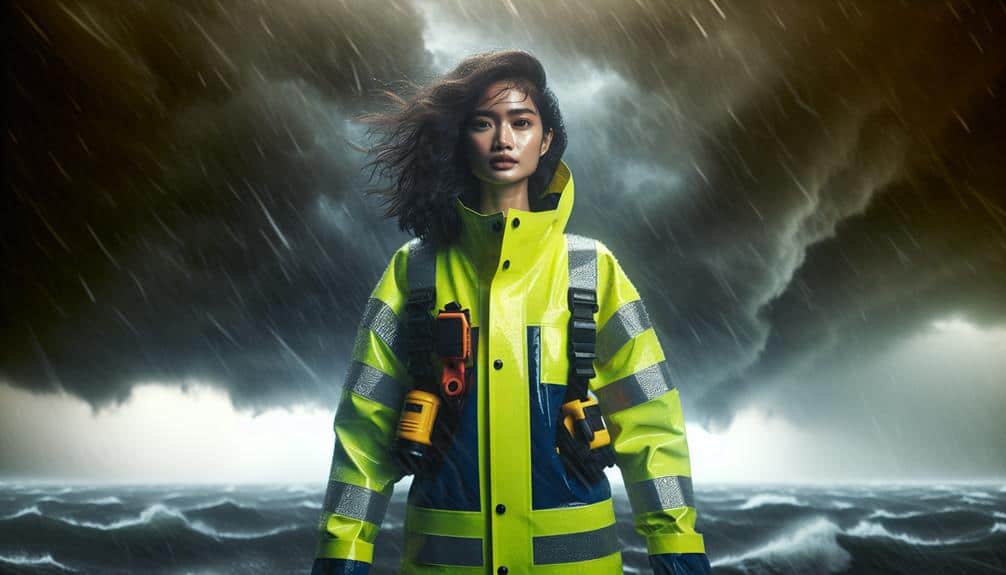
When considering weather-resistant options, we need to focus on waterproof material selection and windproof gear essentials.
High-quality waterproof fabrics protect us from heavy rain, while windproof designs guarantee stability in strong gusts.
Waterproof Material Selection
Selecting the right waterproof material is important for storm chasers to stay dry and safe in extreme weather conditions. When we choose our gear, we need to focus on materials that not only keep water out but also offer a breathable design to prevent overheating. A breathable design guarantees high performance by allowing moisture to escape, which is essential during physically demanding storm chases.
Here are four key considerations for selecting waterproof material:
- Breathability: Look for materials with a high breathability rating. This feature is important to keep us comfortable by allowing sweat to evaporate.
- Durability: Our gear should withstand harsh weather conditions and rough usage. Materials like Gore-Tex are renowned for their durability and reliability.
- Reflective Tape: Incorporate reflective tape into the design for enhanced visibility. This is crucial for our safety, especially in low-light conditions often encountered during storms.
- Seam Sealing: Make sure all seams are fully sealed. This prevents water from seeping through the stitching, maintaining the integrity of the waterproof barrier.
Windproof Gear Essentials
Effective storm chasing demands wind-resistant gear that can withstand intense gusts and offer dependable protection. We need gear that keeps us safe without compromising mobility. The first line of defense is a high-quality wind-resistant jacket. Look for features like sealed seams and adjustable cuffs to prevent wind intrusion.
Pair this with wind-resistant pants that have reinforced knees and seat areas for added durability.
Layering techniques are essential for maintaining warmth and protection. Start with a moisture-wicking base layer to keep sweat off your skin. Add an insulating mid-layer made from fleece or synthetic materials for warmth, followed by your wind-resistant outer layer. This combination ensures optimal temperature control and protection from the elements.
Visibility and safety are vital. Choose gear with high-visibility colors and reflective strips to stay visible in low-light conditions. Additionally, integrated hoods with adjustable drawstrings provide head protection without hindering vision.
Don't overlook accessories like wind-resistant gloves and hats, which are necessary for complete protection. When selecting wind-resistant gear, prioritize materials like Gore-Tex and Windstopper, which offer industry-standard protection against wind while maintaining breathability.
Let's make sure we're equipped to face any storm with confidence and freedom.
Combining Functionality and Comfort
Ensuring that high-visibility gear for storm chasing meets both functionality and comfort requirements is vital for safety and endurance in extreme weather conditions. We need gear that not only stands out but also allows us to move freely and stay protected. Finding the right balance between functionality and comfort can be challenging, but it's essential for our effectiveness in the field.
Functionality is paramount. Our gear should include features like numerous pockets for essential tools, waterproof materials to keep us dry, and reflective strips for maximum visibility. Style shouldn't be overlooked either, as it adds to the overall user experience.
Comfort is equally important. We need gear that breathes well and fits properly, allowing us to be agile and responsive. Durability ensures our investment lasts through multiple storm seasons, enduring harsh conditions without compromising safety or comfort.
Here are four key features to take into account when selecting high-visibility gear:
- Waterproofing: Ensures we stay dry and comfortable.
- Breathability: Prevents overheating and maintains comfort.
- Reflective Elements: Enhances visibility in low-light conditions.
- Multiple Pockets: Provides easy access to essential tools and equipment.
Maintenance and Care Tips
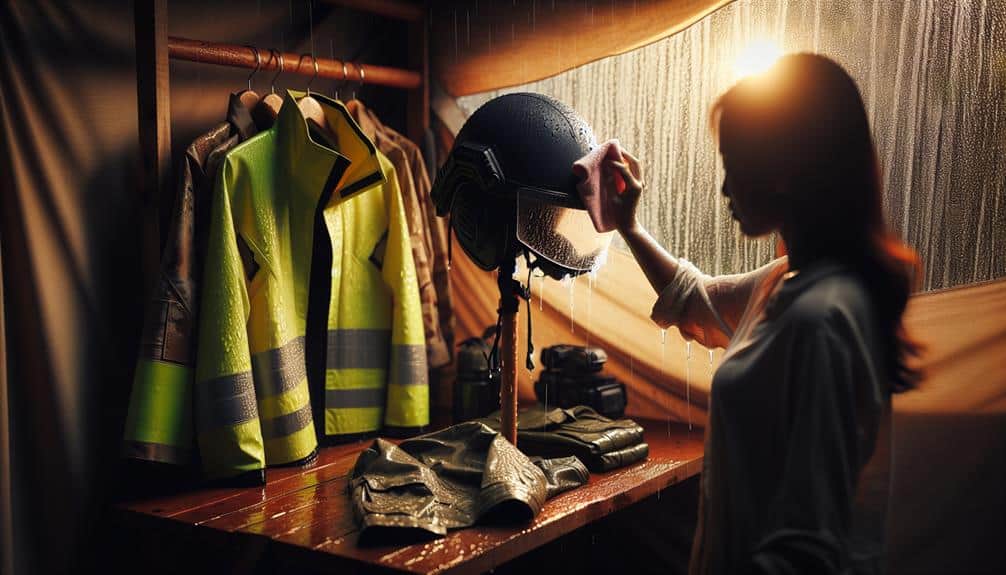
Proper maintenance and care of our high-visibility gear extend its lifespan and help it perform at its best during storm chases. First, let's address cleaning instructions. Most high-vis gear is machine washable, but it's essential to use a gentle detergent and cold water to preserve the reflective material. Avoid fabric softeners and bleach, as they can deteriorate the fabric's reflective properties. After washing, air-dry the gear to maintain its integrity; high heat from dryers can harm the reflective strips.
Next, let's discuss storage tips. Always store our gear in a cool, dry place away from direct sunlight. Prolonged exposure to UV rays can weaken the fabric and fade the high-vis colors. Also, avoid folding the gear along the reflective strips as this can cause them to fracture over time. Instead, hang the gear on a sturdy hanger to keep it in prime condition.
Lastly, regularly examine our gear for wear and tear. Check the seams and reflective strips for any signs of damage. If the reflective material starts peeling or cracking, it's time to contemplate a replacement. Consistent maintenance ensures that our high-visibility gear remains dependable and efficient, keeping us safe during every storm chase.
Frequently Asked Questions
How Should I Store High-Visibility Gear When Not in Use?
We should store our high-visibility gear in a cool, dry place to prevent damage. Proper storage includes hanging items to maintain shape. Maintenance tips include cleaning according to manufacturer instructions and regularly checking for wear and tear.
Can High-Visibility Gear Be Customized With Logos or Names?
Yes, we can customize high-visibility gear with logos or names. Customization options include screen printing and embroidery, ensuring personalized designs meet industry standards while providing the freedom to promote our brand or identity effectively.
Are There Specific Certifications for High-Visibility Gear for Storm Chasing?
When it comes to certification requirements, we can't take shortcuts. High-visibility gear for storm chasing needs to meet specific safety standards like ANSI/ISEA 107. These certifications guarantee our gear provides maximum visibility and protection in extreme conditions.
How Do I Choose the Right Size for High-Visibility Gear?
When selecting the right size, we should review sizing options and visibility features. Consider material choices for durability and comfort. Compare brand options for fit and performance, ensuring the gear meets industry standards for safety and functionality.
Is High-Visibility Gear Suitable for Other Outdoor Activities?
Think of high-visibility gear as a beacon in the wilderness. It's not just for storm chasing; it enhances camping safety and provides excellent hiking visibility. Let's prioritize our safety while enjoying the freedom of the outdoors.
